The year 1977 was a time of “firsts” across America. The world’s first personal all-in-one computer, the Commodore PET was demonstrated, the first Star Wars movie opened, the first space shuttle, the Enterprise, flew its maiden flight and music’s first “King,” Elvis Presley, died at 42. It was also the year when Harley-Davidson scored big time with the first factory outlaw bike, the FXS Low Rider. It came with a 74 c.i. Shovelhead motor, a chain-drive 4-speed and tons of attitude—exactly what motorcycle-hungry consumers were looking for, outselling all other H-D models in its first full year of production. Since then the Low Rider has seen a number of changes over the years while maintaining its legendary custom styling and slammed seat height. And with the midyear 2014 version that was unveiled during Daytona Bike Week, the marque should have little problem in perpetuating a broad customer base.

After a five-year hiatus from The Motor Company’s lineup, the Low Rider was revived with attention focusing on the ability to tune the machine to fit biometric targets of individual riders ranging from 5’1″ to 6’1″ in height (quite an undertaking). While the bike continues to warrant its name with a 25.4″ laden seat height, a clever lumbar bolster is an option that moves the rider forward 1.5″. This removable pad clips into the center Harley medallion and melds perfectly into the contour lines of the seat. (The seat must be removed for installation of the bolster.) And while my 6-foot height did not require the aid of this extension, my stature greatly welcomed the relocated mid controls that have been shoved forward 2″ from the standard Dyna model dimensions, making for a much more relaxed riding position.

But the cool factor never got cooler than the unique handlebar and riser configuration. Using a design reminiscent of the dog-bone risers found on old springer-equipped Harleys, these units provide 2.4″ of adjustment fore and aft. Once you have repositioned the risers, additional versatility is available by loosening the bars and tweaking them a few degrees. We lowered the risers to their lowest point to see if there would be any interference between them and the instrument console, but the engineers have incorporated some ingenious stops to prevent any contact between the two.

Power for the 2014 Low Rider is supplied by a hearty rubber-mounted Twin Cam 103 engine that pumps out 99 ft/lbs of torque at 3500 rpm. It comes with Electronic Sequential Port Fuel Injection (ESPFI) and automatic compression releases to help fire the beast to life without undue wear on the battery. In keeping with its hotrod image, the exhaust is handled by a great-looking 2-into-1 header feeding into a single megaphone muffler, producing a throaty tone when under power. The 6-speed Cruise Drive transmission is finished in wrinkle black powdercoat with chrome covers and provides a great distribution of power throughout hard acceleration runs. The cable-actuated clutch only requires a light touch.

Handling on the 2014 Low Rider is well above average, being one of the bike’s most outstanding features. The stout front fork is a mega 49mm that offers 5.1″ of travel, while the rear features coil-over shocks accented with black springs and chrome end caps providing 3.1″ of bounce. Both front and rear suspension utilize tri-rate springs that are calibrated to initially allow for a softer ride over mild road irregularities while the next two rates progressively become stiffer. The tri-rate springs also minimize front fork diving during aggressive braking. This suspension setup allows for some nimble low-speed handling while taking just about anything thrown their direction when you crank the throttle and decide to go racing. Twin 300mm front discs provide ample stopping power, while the 292mm rear unit is also up to the task. But I did find myself using the front brake almost exclusively since the rear brake pedal was oddly located and always seemed hard to put a boot on with confidence. With an overall rake of 32 degrees (1.5 in the triple trees) and a wheelbase of 64.2″, the steering response is good for a bike weighing in at 644 pounds. Twin Michelin Scorcher “31” tires round out the superb handling characteristics on this year’s model, giving plenty of confidence during cornering. But aggressive riders beware: the low styling of this cruiser guarantees you will drag “something” when tackling the twisties, be it either the pegs or the muffler.
Although the Low Rider comes standard with five-spoke cast aluminum wheels in wrinkle black and diamond cut highlights, the model we tested came with the optional laced wheels (17″ in back and 19” up front). Another option is ABS that will run you an extra $795 over the stock price.
The 2014 Low Rider carries a MSRP of $14,199 for the Vivid Black solid color, while the two-tone samples (Amber Whiskey and Vivid Black or Brilliant Silver and Vivid Black) will run you $14,929. But no matter which option you may choose, this rendition of one of Harley’s most timeless models is the best yet, standing as a prime example of the classic styling that propelled The Motor Company to become a leader in the world of ride-it-till-the-wheels-fall-off attitude while baptizing several generations of bad boys in the process.



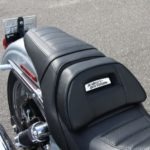
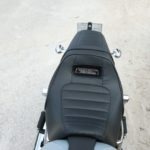
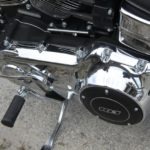
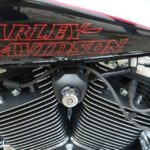
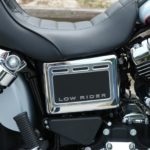


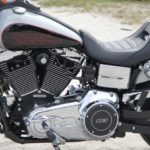

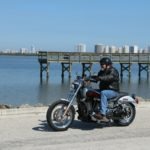
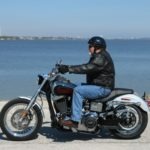
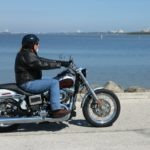
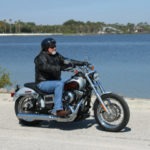
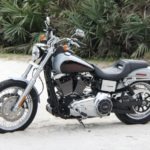
















WOW . Just got this bike for Christmas. Ye haw
Where can I get the seat
I’m 6’3 how comfortable will I be on the bike? How are you liking it?
I’m 6-1 and my guess is you will be comfortable on the bike. I added forward controls to mine and lately I’ve been wondering if that was a mistake. I just (today) put the seat bolster back on to remove some of the forward control distance.
What tools do you need to remove the seat bolster??